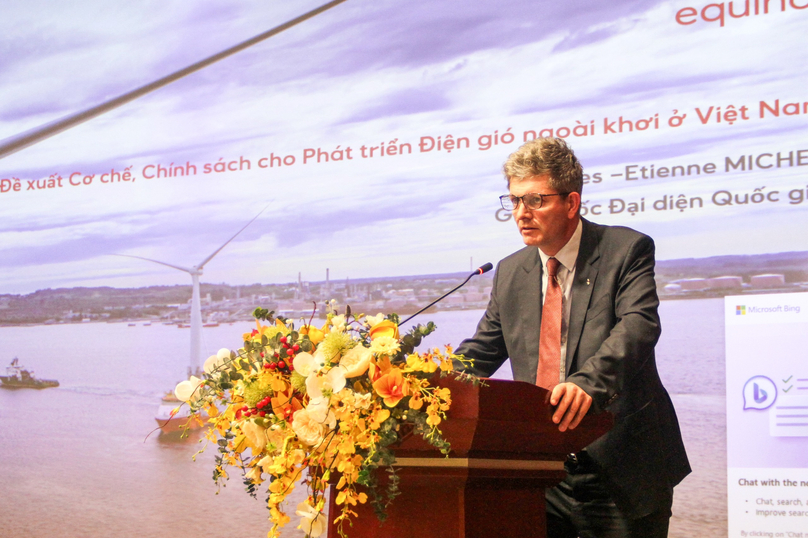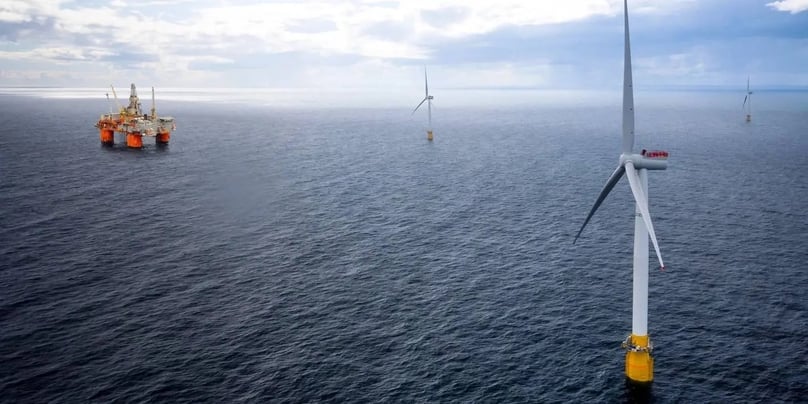Vietnam should speed up implementation of new power plan, offshore wind projects: Equinor
Petrovietnam and Equinor, two state-owned oil-gas firms of Vietnam and Norway, have signed an agreement on clean energy, extending their cooperation to hydrogen, ammonia, carbon capture and storage. On the occasion, The Investor talks to Jacques-Etienne Michel, country managing director and country representative Equinor Vietnam, on Norway's offshore wind development experiences and the firm's plans in the Southeast Asian country.
Offshore wind energy surely has adverse impacts on the maritime environment and the fishing industry, regarding fishing area, impact on biodiversity, and seafood. What are your experiences and recommendations for Vietnam?
Equinor has more than 50 years of offshore energy experience, and more than 15 years in offshore wind. This also means that we have many years of experience of coexistence with other users of the sea, as well as wildlife and biodiversity. Equinor always performs studies to carefully assess the impact of any offshore wind project on the maritime environment and livelihood of other marine users.
As a part of our business development plan for offshore wind projects in Vietnam, we will also perform similar studies, in collaboration with the national and local authorities, developers, communities and other relevant stakeholders.
Normally, such studies as the Environmental and Social Impact Assessment (ESIA) take around two to three years to secure a full understanding of the area. This will serve as an important ground for project developers to discuss with the impacted groups about long-term solutions for harmonious co-existence and cooperation based on mutual trust.
Regulatory frameworks also have an important role in ensuring that the impacts of the offshore wind industry on the marine environment and marine-dependent communities are minimized. Marine Spatial Planning (MSP) is an important tool to support the sustainable use of marine resources and develop arenas for cooperation between users of marine resources.
Norway, similar to Vietnam, has a long coastline. Norway has many experiences in the development and application of Marine Spatial Planning. On that basis, Norway has been a constructive partner of Vietnam in supporting the process of the National Marine Spatial Planning.
Equinor is owned by the Norwegian state, and has numerous experiences in offshore activities, and will continue to provide input based on our experience other places in the world. This can include a variety of topics, including zoning of areas, the lease award procedure, survey operations, and any issues where Equinor experience can be useful in developing a sustainable regulatory regime fit for Vietnam.
We have also seen examples in the UK that offshore wind activity can contribute positively to marine life, where wind turbine substructures function as artificial reefs, creating new ecosystems for sea-based wildlife.

Jacques-Etienne Michel, country managing director and country representative Equinor Vietnam. Photo courtesy of Equinor.
Norway holds ambitious goals in its hydrogen strategy 2020, such as net zero emission in 2050, use of ammonia, development of hydrogen-based transportation. Can you brief about the progress of Norway and Equinor and make recommendations for Vietnam, given that the Ministry of Industry and Trade is drafting the country's hydrogen strategy 2030?
Equinor’s own energy transition plan has four main elements: investing in decarbonizing Norwegian oil and gas production; industrializing offshore wind power; commercializing transport and storage of carbon dioxide (CO2); and scaling up hydrogen production and contributing to a gradual and simultaneous development of market and production capacity.
Vietnam will have to develop its own plan to fit with the Vietnamese context but given the oil-gas activities and Vietnamese experience, Vietnam could consider a similar path where offshore wind power and developing a low carbon solutions (LCS) value chain of hydrogen, ammonia, and carbon capture, utilization, and storage (CCUS) could be part of the long-term strategy to deliver on the net zero ambition by 2050, starting out with blue hydrogen before transitioning into green hydrogen.
To develop the latter, the development of reliable renewable energy production at scale will be a key success factor. In this regard, Vietnam should implement the power development plan VIII (PDP VIII) and scale up offshore wind power production as soon as possible. A green hydrogen value chain will require a large amount of renewable power production that offshore wind can provide.
Equinor is also happy to support the Vietnamese authorities through the latest memorandum of understanding (MoU) signed with Petrovietnam, which include LCS cooperation on company level.

Equinor's Hywind Tampen offshore wind power project in the North Sea. Photo courtesy of Equinor.
Can you elaborate on the cooperation with Petrovietnam? What should Vietnam do to empower offshore wind power businesses, if any? What support can Norwegian businesses and Equinor offer?
Petrovietnam has a very similar identity to us; a national oil and gas company that wants to grow in offshore renewables. One of the strengths that Petrovietnam brings into the collaboration together with their technical arm Petrovietnam Technical Services Corporation (PTSC) is their experience with the local supply chain. This is an important factor for our future success.
Petrovietnam also has a long experience in collaborating with international partners with domestic and overseas experience, and we the two of us have a long-lasting relationship, first starting with collaboration on the gas fields Lan Tay and Lan Do in Vietnam in the 1990s.
As for what Vietnam should do now to empower the offshore wind business, we want to support the Vietnamese government in establishing a sustainable regulatory framework fit for Vietnam. There are many countries competing for renewables investments now. We see Vietnam is an interesting country for us, but competition is fierce, and it is important that Vietnam remains competitive.
Following the good news of PDP VIII approval it is now important to start the implementation phase quickly. We believe it is important that the process is handled by central authorities. Based on our experience from other countries, we believe the following steps could be wise:
Policy and ambition: PDP VIII provides ambitious targets set for offshore wind power, which is one of the first things we look for in a market. Offshore wind power projects typically take seven to 10 years to develop though, so to follow up on the target, clarifying the implementation plan for PDP VIII in a timely manner is important.
Area award/development: The ongoing work to develop marine spatial planning will guide area selection. It is recommended to award the first projects through a fast-track mechanism for Vietnam to remain attractive for international investors that can support local companies to develop projects. This includes updating regulations and awarding survey license rights for local companies in accordance with Vietnamese regulations.
Power grid and connection: We recommend that developers are responsible for offshore grid, while the onshore grid is handled by the Vietnamese state. Strengthening of the grid is needed for offshore wind projects at scale.
Price mechanism: To make sure projects are economically sustainable, a revenue support mechanism must be developed for the first projects and for future auctions, so that developers see a sustainable business case in the projects. This includes making sure that the power purchasing agreements are bankable, of a standard that means that projects can be financed through loans from banks. We also think direct power purchase agreements (DPPA) will be an important tool to ensure commercial viability of projects in Vietnam. This is when large users of power, industrial plants, buy power directly from renewable projects.
Supply chain industry: Vietnam has a strong oil-gas supply chain which can be used to deliver to offshore wind power. We need to stimulate voluntary collaboration and support promoting local suppliers. The renewables industry is an inherently local business. Equinor has helped develop a supply chain report together with the Norwegian Embassy, and currently another follow-up study on supply chain management capabilities in Vietnam is being developed.
Equinor can offer 50 years of experience of operating offshore. Equinor is a major global offshore wind player, with competence within development, construction, installation and operation. Equinor is now finalizing the commissioning of the world largest offshore wind fam in UK, and we want to bring this experience to Vietnam too.
Equinor is an international broad energy company with its headquarters in Norway, with 22,000 employees in 30 countries. For over 50 years, Equinor has been turning natural resources into energy for people and progress for society.
Vietnam is one of the worlds’ fastest growing economies and power markets. With its long coastline and favorable wind conditions, the country has among the best wind resources in Asia and a strong desire to develop an offshore wind market. Equinor said it believes the country has high potential to become an interesting growth market for offshore wind and therefore opened a representative office in Hanoi in May 2022.
Equinor said the firm's ambition is to utilize its offshore experience and broad energy competence to support Vietnam’s energy transition, paving the way for renewables growth.
PetroVietnam and Equinor have a long-lasting relationship, first starting with collaboration on the gas fields Lan Tay and Lan Do in Vietnam in the 1990’s. Equinor has signed two MoUs with PetroVietnam for strategic cooperation, first on offshore wind (2021) before recently expanding the collaboration to also include low-carbon solutions (November 2023).
Equinor has helped develop a Vietnam Supply Chain Study Report for offshore wind. The report provides an overview of the entire supply chain for Vietnam’s offshore wind industry and highlights opportunities that offshore wind can bring to Vietnamese suppliers.




